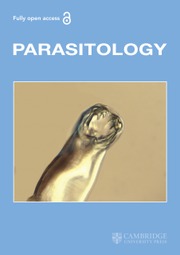Crossref Citations
This article has been cited by the following publications. This list is generated based on data provided by
Crossref.
Davies, Keith G.
2009.
Natural History of Host-Parasite Interactions.
Vol. 68,
Issue. ,
p.
211.
ALIZON, S.
HURFORD, A.
MIDEO, N.
and
VAN BAALEN, M.
2009.
Virulence evolution and the trade‐off hypothesis: history, current state of affairs and the future.
Journal of Evolutionary Biology,
Vol. 22,
Issue. 2,
p.
245.
Allen, Desiree E.
and
Little, Tom J.
2011.
Dissecting the effect of a heterogeneous environment on the interaction between host and parasite fitness traits.
Evolutionary Ecology,
Vol. 25,
Issue. 2,
p.
499.
Pauwels, Kevin
De Meester, Luc
Decaestecker, Ellen
and
Stoks, Robby
2011.
Phenoloxidase but not lytic activity reflects resistance against
Pasteuria ramosa
in
Daphnia magna
.
Biology Letters,
Vol. 7,
Issue. 1,
p.
156.
COORS, ANJA
and
DE MEESTER, LUC
2011.
Fitness and virulence of a bacterial endoparasite in an environmentally stressed crustacean host.
Parasitology,
Vol. 138,
Issue. 1,
p.
122.
López‐Villavicencio, Manuela
Courjol, Flavie
Gibson, Amanda K.
Hood, Michael E.
Jonot, Odile
Shykoff, Jacqui A.
and
Giraud, Tatiana
2011.
COMPETITION, COOPERATION AMONG KIN, AND VIRULENCE IN MULTIPLE INFECTIONS.
Evolution,
Vol. 65,
Issue. 5,
p.
1357.
Vale, Pedro F.
Wilson, Alastair J.
Best, Alex
Boots, Mike
and
Little, Tom J.
2011.
Epidemiological, Evolutionary, and Coevolutionary Implications of Context-Dependent Parasitism.
The American Naturalist,
Vol. 177,
Issue. 4,
p.
510.
Luijckx, Pepijn
Ben‐Ami, Frida
Mouton, Laurence
Du Pasquier, Louis
and
Ebert, Dieter
2011.
Cloning of the unculturable parasite Pasteuria ramosa and its Daphnia host reveals extreme genotype–genotype interactions.
Ecology Letters,
Vol. 14,
Issue. 2,
p.
125.
Mohan, Sharad
Mauchline, Tim H.
Rowe, Janet
Hirsch, Penny R.
and
Davies, Keith G.
2012.
Pasteuria endospores from Heterodera cajani (Nematoda: Heteroderidae) exhibit inverted attachment and altered germination in cross-infection studies with Globodera pallida (Nematoda: Heteroderidae).
FEMS Microbiology Ecology,
Vol. 79,
Issue. 3,
p.
675.
Ojosnegros, Samuel
Delgado-Eckert, Edgar
and
Beerenwinkel, Niko
2012.
Competition–colonization trade-off promotes coexistence of low-virulence viral strains.
Journal of The Royal Society Interface,
Vol. 9,
Issue. 74,
p.
2244.
Schoebel, Corine N.
Auld, Stuart K. J. R.
Spaak, Piet
Little, Tom J.
and
Gerardo, Nicole M.
2014.
Effects of Juvenile Host Density and Food Availability on Adult Immune Response, Parasite Resistance and Virulence in a Daphnia-Parasite System.
PLoS ONE,
Vol. 9,
Issue. 4,
p.
e94569.
Auld, Stuart K. J. R.
Wilson, Philip J.
and
Little, Tom J.
2014.
Rapid change in parasite infection traits over the course of an epidemic in a wild host–parasite population.
Oikos,
Vol. 123,
Issue. 2,
p.
232.
Vargas-Sanchez, Gie-Bele
Romero-Valdovinos, Mirza
Ramirez-Guerrero, Celedonio
Vargas-Hernandez, Ines
Ramirez-Miranda, Maria Elena
Martinez-Ocaña, Joel
Valadez, Alicia
Ximenez, Cecilia
Lopez-Escamilla, Eduardo
Hernandez-Campos, Maria Elena
Villalobos, Guiehdani
Martinez-Hernandez, Fernando
Maravilla, Pablo
and
Escobar-Gutiérrez, Alejandro
2015.
Blastocystis Isolates from Patients with Irritable Bowel Syndrome and from Asymptomatic Carriers Exhibit Similar Parasitological Loads, but Significantly Different Generation Times and Genetic Variability across Multiple Subtypes.
PLOS ONE,
Vol. 10,
Issue. 4,
p.
e0124006.
Abbate, Jessica L.
Kada, Sarah
Lion, Sébastien
and
Rall, Glenn F
2015.
Beyond Mortality: Sterility As a Neglected Component of Parasite Virulence.
PLOS Pathogens,
Vol. 11,
Issue. 12,
p.
e1005229.
Clerc, Melanie
Ebert, Dieter
and
Hall, Matthew D.
2015.
Expression of parasite genetic variation changes over the course of infection: implications of within-host dynamics for the evolution of virulence.
Proceedings of the Royal Society B: Biological Sciences,
Vol. 282,
Issue. 1804,
p.
20142820.
Ebert, Dieter
Duneau, David
Hall, Matthew D.
Luijckx, Pepijn
Andras, Jason P.
Du Pasquier, Louis
and
Ben-Ami, Frida
2016.
Vol. 91,
Issue. ,
p.
265.
Bendis, Randall J.
and
Relyea, Rick A.
2016.
Wetland defense: naturally occurring pesticide resistance in zooplankton populations protects the stability of aquatic communities.
Oecologia,
Vol. 181,
Issue. 2,
p.
487.
Kamidi, Christine M.
Auma, Joanna
Mireji, Paul O.
Ndungu, Kariuki
Bateta, Rosemary
Kurgat, Richard
Ouma, Collins
Aksoy, Serap
and
Murilla, Grace
2018.
Differential virulence of camel Trypanosoma evansi isolates in mice.
Parasitology,
Vol. 145,
Issue. 9,
p.
1235.
Wang, Yin
and
Rozen, Daniel E.
2019.
Fitness costs of phoretic nematodes in the burying beetle, Nicrophorus vespilloides.
Ecology and Evolution,
Vol. 9,
Issue. 1,
p.
26.
Rowntree, Jennifer K.
Craig, Hayley
and
Thrall, Peter
2019.
The contrasting roles of host species diversity and parasite population genetic diversity in the infection dynamics of a keystone parasitic plant.
Journal of Ecology,
Vol. 107,
Issue. 1,
p.
23.




